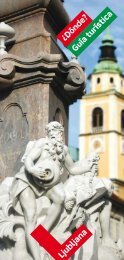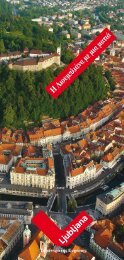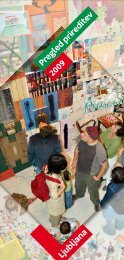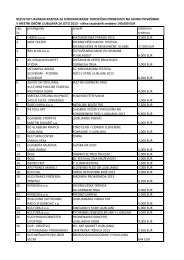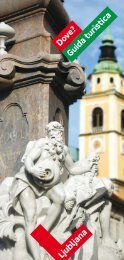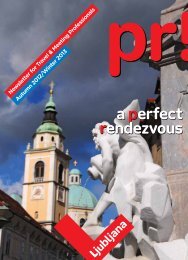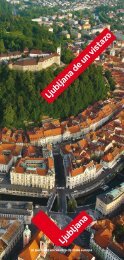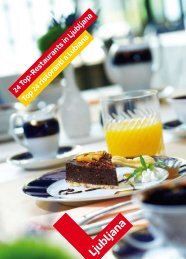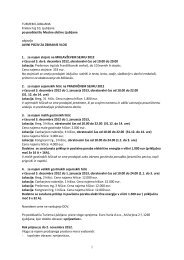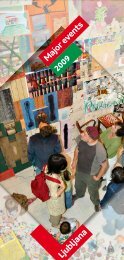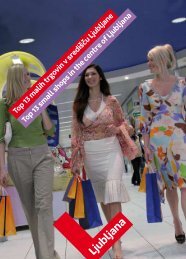English - Ljubljana
English - Ljubljana
English - Ljubljana
- No tags were found...
Create successful ePaper yourself
Turn your PDF publications into a flip-book with our unique Google optimized e-Paper software.
Photo: J. Bavcon200th Anniversary of the<strong>Ljubljana</strong> Botanic GardenThe <strong>Ljubljana</strong> Botanic Garden, founded in 1810, is recognized as Slovenia’soldest running cultural, scientific and educational institution.The Garden contains over4,500 plant species, subspeciesand varieties, a third of whichare native to Slovenia and therest introduced from variousparts of Europe and othercontinents. The Garden isinvolved in scientific researchMedal for DesignA gold medal for best industrialdesign awarded by the BIO 21industrial design biennial lastOctober went to the <strong>Ljubljana</strong>Castle Funicular, designed by theAmbient design studio. In its report,the jury said that “the funicular’sunobtrusive contemporary designadds to the traditional culturalidentity of <strong>Ljubljana</strong> Castle andcontributes to the dialoguebetween the old and the new”.60th Anniversary of the <strong>Ljubljana</strong> ZooThe <strong>Ljubljana</strong> Zoo is a modern zoo breeding native species and a few non-native amphibian, reptile,bird and mammal species. It is situated within a nature park, on the slopes of <strong>Ljubljana</strong>’s Rožnik hill.It covers an area of 19.6 hectares and has a network of 6.5 kilometres of paths.A visit to the zoo is an excitingexperience for children andadults alike. The <strong>Ljubljana</strong> Zoooffers a diverse variety of animalCommon Snowdrop of <strong>Ljubljana</strong>In early spring, the city’s gardens and parks, its surrounding hills,<strong>Ljubljana</strong> Marshes and the banks of the Sava river are covered bya sea of white common snowdrops, including those of the newGalanthus nivalis ‘<strong>Ljubljana</strong>’ variety, described in the book CommonSnowdrop (Galanthus nivalis L.) and Its Diversity in Slovenia. Theouter perianth segments of the new variety are intensely bluishgreenfrom the tips to almost one half of the segments. From there,the coloration continues in the form of bluish-green lines fadinginto white. The pattern of inner perianth segments is of the samecolour and extends to one half of the segments.experiences, from strokinganimals to observing them atfeeding time. The upper part ofthe Zoo is home to animals ofnative species including a deer,an owl and several domesticcarnivores: a wildcat, a lynx,and a wolf and a brown bearfamily. Other interesting speciesinclude insects, spiders, reptilesand amphibians. Photo-safarisare organized once in each ofthe four seasons. Night toursare run and overnight campingis allowed on Thursdays and<strong>Ljubljana</strong> Zoo,Photo: D. Wedamand educational activities andcollaboration with more than300 botanic gardens fromaround the world. It plays animportant role in the cultivationand protection of Slovenia’sendemic and endangered plantspecies. One of its most valuedtreasures is Fleischmann’sparsnip (Pastinaca sativa var.fleischmanni), a Slovenianendemic species extinct in thewild. Throughout botanicalliterature, the <strong>Ljubljana</strong> BotanicBotanical Garden,Photo: J. BavconSaturdays in July and August.The Zoo also organizesmemorable birthday parties. Asignificant day in its calendaris Midsummer’s Night, when,Garden is considered to be itsonly remaining habitat.The <strong>Ljubljana</strong> Botanic Gardenis one of the world’s foremostbotanic gardens described intext and pictures in the bookBotanic Gardens: A LivingHistory, published in 2007 bythe Black Dog Publishing Ltd. inLondon.Due to its greensurroundings, the Garden isa pleasant place for a walkor relaxation in the shade oftrees. Its appearance changesseasonally and to experienceits entire wealth of flora it iswell worth visiting at differenttimes of the year. Admission isfree. At a charge, guided toursof the Garden can be arrangedfor groups of plant lovers andpupils and students at all levelsof education.www.botanicni-vrt.si,www.visitljubljana.siaccording to an old superstition,animal speech is understoodby those who have a fern seedin their shoe and do not knowabout it. www.zoo-ljubljana.siNatural Science Day for the BlindEach year in September, the <strong>Ljubljana</strong> Zoo organizes anatural science day for the blind and visually impaired. Thisyear on 24 September, animals will be available for strokingand holding at five points in the Zoo. Some species will bepresented with the aid of taxidermy animals, bones, skulls,horns, feathers and fur. Strings of various lengths, bags ofdifferent weights, fur samples, reliefs and footprints will beused as aids in creating mental pictures.Photo: Pri Vodniku Archive<strong>Ljubljana</strong> is situated at theconfluence of four Slovenianregions. For this reason, adiverse range of dishes areserved both in modern andtraditional “gostilna” restaurantsacross the city and itssurrounding areas. The choiceof cuisines is vast. Restaurantsoffer dishes from around theworld and traditional Slovenianfare is well represented.Všenat zeleParticularly in <strong>Ljubljana</strong>’ssurrounding areas, “všenatzele”, i.e. sauerkraut with milletgroats, was a typical lunch dishin the past. It was often servedfor lunch at haymaking, alsowhen hay was harvested fromthe meadows located within thecity.The word “všenat” isNew RestaurantsWhat is special about eating out in <strong>Ljubljana</strong> is that a lot ofupscale restaurants serve reasonably priced lunchtime menus.The choice of restaurants serving international cuisines is growingand traditional Slovenian “gostilna” restaurants are plentiful.Recent openings include Harfa (Koprska ulica 98), which servesinternational cuisine, Taco Time Mexico (Dalmatinova ulica 2),the Asian restaurant Shambala (Križevniška ulica 12) and the“gostilna” restaurants Stari Tišler (Kolodvorska ulica 8) and PriVodniku (Vodnikova cesta 65a). The latter two also provideaccommodation. www.visitljubljana.si/experience<strong>Ljubljana</strong> Specialtyon Your PlateIn this section, each issue of the magazine willpresent a dish which constitutes an importantpart of the culinary cultural heritage andpresent-day culture of the Slovenian capitaland its surrounding areas.derived from the dialectal word“všen(o)”, which means thesame as the proper Slovenianword “pšeno”: husked milletgrain or millet groats.The making of sauerkrautand sauerrüben (grated andfermented cabbages andturnips) has a long tradition in<strong>Ljubljana</strong> and its surroundingareas. In the suburbs of Trnovoand Krakovo it can be tracedback to the 19th century, butparticularly the lower classeswere familiar with it alreadyback in the 17th century.The sauerkraut fromthe suburb of Trnovo had awidespread reputation and wasappreciated even in Vienna.Legend has it that on a visit to<strong>Ljubljana</strong>’s Slon hotel, Emperor»Všenat zele«,Photo: T. Jeseničnik<strong>Ljubljana</strong> Market, Photo: B. Jakše JeršičFranz Joseph of Austria ordered“Eisbein mit Sauerkraut”, i.e.boiled knuckle of pork withsauerkraut. As the Germanword “Eisbein” means “frozenleg” in direct translation, thehotel’s chef was surprised whenhe heard what the emperorhad ordered. “Are our graciousEmperor’s teeth good enoughto deal with a frozen knuckle ofpork,” he asked the emperor’scook, who quickly explainedthat “Eisbein” was the Germanword for boiled knuckle of pork,which was called “frozen leg”in German because pork calfVšenat zeleLate-Hours HungerFor those with a hunger for late night foodand fun, Grand Casino <strong>Ljubljana</strong> is theright place to go. Its a la carte restaurant,open from 6 p.m. to 2 a.m., serves a fineselection of dishes to both gambling andnon-gambling guests. The menu changesseasonally, but Mediterranean tastes andfresh Neapolitan pasta are always there.Special menus can be arranged for largergroups. www.casino-lj.sibones were used in makingchildren’s ice skates.Sauerkraut stands arestill a common sight at<strong>Ljubljana</strong>’s Central Marketand an important part of itsidentity. Numerous locals makeit a habit to drink sauerkrautwater, a by-product in cabbagefermentation referred to as“zeljnica” in Slovenian, for itsbeneficial effects on digestionand stomach conditions. Someof those who tend to havea glass too many, drink it torelieve hangover.Janez Bogataj PhD500 g millet groats, 1000 g sauerkraut, salt, water,cracklings, lard1. Rinse sauerkraut in cold water and drain. Place in acasserole.2. Add millet groats washed in cold water and enoughwater to cover both ingredients.3. Cook until thick. While cooking, add water as necessary.4. Before serving, sprinkle with melted lard with cracklings.As an optional ingredient, dried meat cut into smallpieces may be added to the recipe. The cooking methoddescribed above can also be used to prepare “všenatarepa”, a similar dish in which sauerkraut is replaced bysauerrüben (grated and fermented turnips). In preparinglarger amounts of the dish, make sure to maintain the milletgroats to sauerkraut/sauerrüben ratio of 1:2.
Antiq, Photo: Ž. KoritnikWhen day turns into nightand all shops, museums andgalleries close, the city doesnot fall asleep, but becomesalive once again. The rangeof what <strong>Ljubljana</strong> has to offeris wide and varied and, mostimportantly, of good quality.Every night, no matter howwild, begins with an evening,the time to visit places like theCankarjev dom cultural andcongress centre, Slovenia’slargest cultural institution/www.cd-cc.si/, the SlovenianNational Opera and BalletTheatre /www.opera.si/,architect Plečnik’s Križankesummer theatre or the lesserknown Old Power Station/www.bunker.si/stara-elektrarna.Each of them offers a qualityprogramme of concerts, danceand theatre performances, andmuch more.Those wishing to observethe sunset can do so whilechatting over a glass of finewine at one of the city’snumerous bars and pubslocated on the romanticembankments of the Ljubljanicariver and in the city’s parks andBoutique HotelsSpring 2008 saw the opening of the Ahotel <strong>Ljubljana</strong>. Due toits pleasant ambience, quality modern furnishings and locationon a main approach road to <strong>Ljubljana</strong>, only two kilometres fromthe city centre, it provides a pleasant stay even for the mostdiscerning guests, including business travellers. www.ahotel.siAnother charming boutique hotel, located in a historic buildingin the heart of the old city centre, is the Antiq Hotel. Its stylish,comfortable rooms, some with terraces or furnished to reduceallergy risk, make for a unique city experience.www.antiqhotel.sihidden nooks and crannies.Others may prefer a vibrant pubevening over a beer with sportsprogrammes on TV or maybe anactive night out with their dancebuddies. At least once a week,several city venues host danceevents, the most popular beingsalsa, swing and tango nights.Several casinos cater for thosewith a sweet tooth for fun andgaming.“Night has might,” says aSlovenian proverb and <strong>Ljubljana</strong>,comparable to big cities inits diverse range of late-nightentertainment, definitelyillustrates it. As a bonus, itcomes with a friendly andintimate atmosphere.New club openings includeZlati zob /www.myspace.com/etnoklubzlatizob/, theonly “ethno club” in the widercity area, whose music policyfocuses on Balkan and otherfolk musics, the centrallylocated Flex Club for the loversof jazz, and Roxly bar/www.roxly.si/ for fans ofhard rock rhythms. Proofof the diversity of the city’sclub offerings is the newlyMetelkova Mesto,Photo: A. PavanFeeling at Home at a ClubIf in the 1990s you despaired of nightlife in <strong>Ljubljana</strong>, today, a good decade later,you will be pleasantly surprised.opened Hard Core Cafe,intended, according to itsowners, for “socializing andpleasure without prejudice”.Well established clubs formusic lovers include the highlyacclaimed Jazz Club Gajo/www.jazzclubgajo.com/and Franci na Balanci/www.nabalanci.si/, somethingof a peculiarity in <strong>Ljubljana</strong>,which makes sure that the localsdo not forget the Slovenianturbofolk and popular folkmusic.There are also a range ofclassical nightclub options. Thecity’s vibrant student scene iscentred around the Klub KMŠclub /www.klub-kms.si/. Formainstream clubbing, visit thestate-of-the-art nightclubUltra /www.ultra-club.si/,the well established BachusWorld’s HippestHostelPub Crawl ExperienceAccording to the Lonely PlanetBluelist 2006, <strong>Ljubljana</strong> boasts“the hippest hostel in the world”. Thefamous hostel, which celebrates its5th anniversary this year, is an artfullyconverted military prison known asHostel Celica. Its rooms, former prisoncells decorated by young artists,still have barred doors and windowsreminiscent of the building’s past.Rough Guides listed Hostel Celicaamong the world’s 25 ultimate placesto stay. www.hostelcelica.comExperience a night out in <strong>Ljubljana</strong> as a VIP guest, withouthaving to line up in front of entrances. Take part in anorganized pub crawl including a selection of three pubsand a nightclub. At each of the places you will be serveda complimentary drink. www.visitljubljana.si/www.bachus-center.com/ orHvala za rože, situated underthe famous Central MarketColonnade. More demandingparty goers can choose fromthe legendary Klub SubSub/subsub.si/, Cvetličarna/www.cvetlicarna.eu/, wheredisco lights flash on Fridays,the newly revamped Inbox/www.inbox-club.si/ and,last but not least, Klub K4/www.klubk4.org/, the foremostclub in <strong>Ljubljana</strong> promotingquality contemporary urbanmusic. /www.klubk4.org/.A very special venue forclub events is the Metelkovamesto alternative culture centre/www.metelkova.org/, housedin a former barracks complexrefurbished in a unique way byyoung artists and well knownacross Europe. Its numerousvenues provide soul food foranyone with a hunger for qualityunderground music. The rangeof musical genres represented isalmost endless.Tjaša JanovljakWant to know where the locals dine, shop, relax, enjoy musicand more? Wish to experience the city “the local way”?If yes, you might be interested in a series of European cityblogs entitled Spotted by Locals. To check out updatedrecommendations posted by Ljubljanians, visit the websiteat www.spottedbylocals.com/ljubljana.<strong>Ljubljana</strong> CavalierFrom this summer, <strong>Ljubljana</strong> Cavalier willbe riding in his electric vehicle seatingfive passengers around the CentralMarket and the rest of the city centre’spedestrian area to help shoppers withtheir bags. His assistance will be availableall year round, free of charge – a gestureof goodwill from the City of <strong>Ljubljana</strong> toresidents and visitorsPick a City Tourof Your ChoiceThe first one, on view from16 April to 16 June, is MatevžLenarčič’s The Alps as Seenby Birds. 120 photographsmeasuring 180 by120 centimetres are dedicatedto the Alps to mark Slovenia’stwo-year presidency of thePhoto: T. Jeseničnik<strong>Ljubljana</strong> boasts an extraordinarily large numberof sights, picturesque areas and pleasant nooksand crannies so the choice of guided city tours iswide and varied.Tours range from regularlyscheduled walking and boattours, some including touristroad train and funicular rides,to cycle, balloon and specialexperience and themedwalking tours, available byprior arrangement. From 1 May,when reconstruction works onthe Ljubljanica river’s Špicaembankment and its newfootbridge will be completed,a new city tour will be availablein addition to the existing 22.The tour will include a walk ofthe old city centre and <strong>Ljubljana</strong>Castle, an expert guided tourof the <strong>Ljubljana</strong> Botanic Gardenand a tourist boat ride fromthe Špica embankment to thestarting point, the Triple Bridge.One of the more interestingcity tours, known as TheDragon Code tour and availableby appointment from June toSeptember, is an adventuretour taking participants to theAlpine Convention, whichbegan in March. In addition, amonograph entitled The Alpswill be published in Slovenianand <strong>English</strong>.The next exhibition, From Earthto Space, set up by UNESCORenovated Souvenir ShopA new souvenir shop has opened at the Tourist InformationCentre in Stritarjeva ulica. Daily from 10 a.m. to 7 p.m., visitorscan choose from souvenirs reflecting the typical featuresof <strong>Ljubljana</strong> by combining traditional arts and crafts withcontemporary design. The souvenirs which, according to anexpert jury, best reflect <strong>Ljubljana</strong> are branded as Souvenir of<strong>Ljubljana</strong>. Particularly notable are the T-shirts, hats and cupsfrom the <strong>Ljubljana</strong> Is a Beautiful City collection, also becauseanyone who has visited <strong>Ljubljana</strong> agrees with the statement.www.visitljubljana.simysterious world of imaginationand symbolism, on a missionto lift the veil of mysteryhanging over an ancientpiece of wisdom passed onthrough centuries by a secretbrotherhood called Kazamate.Experience-basedlearning about the city’s art,architecture, sights and ancientlegends brings participants tothe heart and soul of <strong>Ljubljana</strong>,making them switch from therole of mere observers to therole of active participants.Unveiling the secrets behindthe city’s façades and activelyreviving stories from the past,they get a completely newperspective on the city. Onceall the tasks are completed, themystery of the Dragon Code isrevealed, making participantsrealise that <strong>Ljubljana</strong> has mostto offer to those who look withtheir hearts.Tivoli Park’s Open-Air GalleryThroughout spring and summer, the Tivoli park’s Jakopičevo sprehajališče walkwill be hosting open-air photographic exhibitions.to mark the InternationalYear of Astronomy, will bringtogether photographs taken byprofessional observatories, theHubble space telescope andamateur astronomers, includingSlovenian ones.Tour in Old Town,Photo: D. WedamMatevž Lenarčič’s Exhibition,Photo: M. Lenarčič<strong>Ljubljana</strong> BikeOn a warm day, ridinga bicycle is one of themost pleasant ways ofgetting around <strong>Ljubljana</strong>city centre.Each year from Apriltill the end of October(if weather permits),an 80-strong fleet of<strong>Ljubljana</strong> Bikes can behired by both touristsand residents fromthe Slovenian TouristInformation Centre andother locations across thecity. Bicycles are availabledaily from 8 a.m. to 7 p.m.in April, May and October,and from 8 a.m. to 9 p.m.from June to September.
10 1150th <strong>Ljubljana</strong> Jazz FestivalMadonna ConcertMuseum Summer NightArt Cafe TivoliFrom 29 June to 4 July, the Križanke summer theatre, Cankarjevdom’s Klub CD club and the Metelkova mesto alternative culturecentre will host some of the biggest names in jazz as part of the50th <strong>Ljubljana</strong> Jazz Festival. The opening night will feature JohnZorn, one of the most distinguished musicians and composersof the last three decades, who has never before appeared at theFestival. Accompanying events will include an exhibition of jazzphotographs and posters and screenings of films themed onjazz. Klub CD and its café will be open for socializing throughoutthe day. www.ljubljanajazz.siSource: Dancing BearOn 20 August, the Queen of Pop,Madonna, will make an appearance at<strong>Ljubljana</strong>’s Hipodrom Stožice hippodrome.Her concert will be part of her muchtalked-about concert tour “Sticky &Sweet”, promoting her latest album HardCandy. Last year, the Sticky & Sweetconcerts, noted for spectacular visualeffects and choreography, were attendedby more than 2.35 million Madonna fans.The 7th Museum Summer Night, set to be held on 20 June,will turn several centrally located squares, street corners andcourtyards into inviting islands of light.The Museum Summer Night is a joint open day held bySlovenia’s museums, galleries and other exhibition venues.No tickets are required to view collected treasures or take partin a programme of workshops, demonstrations, film screenings,presentations, guided tours, lectures, literary readings andperformances culminating in midnight concerts and socialgatherings.Photo: Kaval GroupArt Cafe Tivoli has recently opened atthe International Centre of Graphic Arts.Fragrant coffee and sweet delights canbe enjoyed along with art, soothing musicand maybe a book on <strong>Ljubljana</strong>. The areain front of the café, rising above the Tivolipark’s tree-lined Jakopičev drevored walkand offering one of the most beautifulviews of <strong>Ljubljana</strong>, is a venue for summerevents.Ana Desetnica Festival,Photo: D. WedamBetsabeé Romero, Cities That Leave,4 engraved tires printed on various household fabrics, 2004Photo:In a Whirl of Culture and FunA lively programme of cultural events for all ages is in store for <strong>Ljubljana</strong> thissummerThe most daring item onthe programme will be thestaging of the ballet SwanLake on an open-air stagein the Prešernov trg squarein June. The creators of thisfour-act show have added aSlovenian parallel to the storyabout Prince Siegfried, Odette/Odille and Rothbard, usingthe tragic life story of FrancePrešeren, a giant of Slovenianpoetry, as the ballet’s centraltheme. The ballet depictsPrešeren’s unrequited lovefor Julija Primic, his turbulentand tiresome relationship withAna Jelovšek, the motherof his three children, and hispersonal distress, which led toa devastating alcohol addiction,melancholy and eventuallydeath. Despite the changesto the story, the audienceswill still be able to enjoy theclassic elements of Swan Lake,including the famous pas dedeux, big and small swans, andcharacteristic chorus scenes.In early July, the streetsand squares of <strong>Ljubljana</strong> willhost the 14th Ana Desetnicainternational street theatrefestival. Events will includeanything from simple streettheatre performances tomultimedia spectacles involvingacting, live music and visuals.Throughout August, theTrnfest 09 festival will be heldat the KUD France Prešerenarts and cultural centre. Itsmixed programme of music,theatre, dance, film, fine art andphotography will feature artistsfrom home and abroad. Morethan 30 days and nights of freeentertainment are in store foryoung, old and the youngestalike.In the end of August, theold city centre’s streets andsquares will host concerts andother events as part of theNight in <strong>Ljubljana</strong> Old Townfestival, which traditionallyrounds off the Summer in<strong>Ljubljana</strong> Old Town festival andmarks the conclusion of thesummer event season.www.visitljubljana.si<strong>Ljubljana</strong> Festival 2009Night in <strong>Ljubljana</strong> Old Town,Photo: LTB ArchiveFrom 6 July to 27 August, the Križanke summer theatre,<strong>Ljubljana</strong> Castle, Cankarjev dom cultural and congresscentre, Slovenian Philharmonic Hall and several othervenues will host the 57th <strong>Ljubljana</strong> Festival.Festival highlights will include Bolshoi Theatre’sproduction of the opera Eugene Onegin, two concertsby the Schleswig-Holstein Music Festival Orchestra andChoir, a concert by London Symphony Orchestra underthe baton of Valery Gergiev, a performance by RussianCossacks, Tomaž Pandur’s reworking of Shakespeare’sHamlet performed by Madrid’s Teatro Español, an eveningof flamenco, and a traditional concert by Vlado Kreslin. Inorder to pay homage to <strong>Ljubljana</strong>’s rich musical heritage,one of the festival evenings will be dedicated to the famouscomposer Gustav Mahler, who began his creative career in<strong>Ljubljana</strong>.A full programme of events is available from the website atwww.ljubljanafestival.si.It treats printmaking, andreproducible art in general,as an important tool of artand civilisation which notonly reflects but also changesartistic, political, economic andideological systems. Complexin its conception, it consistsof several exhibitions and anartists’ book salon.The 28th edition of theBiennial will take place from1 September to 25 October.The main exhibition, Matrix: AnUnstable Reality, will presenta selection of prints, artists’books, art newspapers andother works by internationalartists selected in collaborationwith <strong>Ljubljana</strong>’s art galleriesto reflect both traditionalprintmaking techniques andcontemporary reproductionmethods. Exhibited works willTriennial of Ceramic ArtThe Unicum triennial aims atpopularizing ceramic art andencouraging the recognitionof it as an art discipline in itsown right, both in Sloveniaand abroad. Along with aseries of accompanyingevents, it will be a frameworkfor presenting traditionalpottery and ceramics, thetechnological developmentof the art of making uniquehandmade ceramic objectsand the achievements of bothestablished and emergingyoung artists from Slovenia andabroad.The main exhibition will28th Biennialof Graphic ArtsThe <strong>Ljubljana</strong> International Biennial of GraphicArts, founded in 1955, is Slovenia’s longest runningexhibition event and one of the world’s oldestprint biennials.be on view at the InternationalCentre of Graphic Arts, severalgalleries and in public mediaspaces.An exhibition of works bythe South Korean artist JeonJoonho, the grand prize winnerat the 27th Biennial, will beon view at the Cankarjev domcultural and congress centreunder the title Korea Fantasy99°C. The Slovene EthnographicUnicum 09, the first <strong>Ljubljana</strong> international triennial of ceramic art, willbe held from mid-May to September at various venues across Slovenia.The main events will take place in <strong>Ljubljana</strong>.feature works by 76 artists from29 countries selected from 133applicants by an internationaljury. It will be held at the newpremises of the NationalMuseum of Slovenia in theMetelkova ulica street, whichwill also host an exhibitionof ceramic art by art schoolMuseum will host an exhibitionof comic books and prints bycomic book artists entitledGreetings from Cartoonia. ThePionirski dom children’s culturalcentre, which has been involvedin children’s printmaking formany years, will set up anexhibition of children’s printsentitled Impressions.www.mglc-lj.sistudents. Another exhibition,held at <strong>Ljubljana</strong> Castle’sCasemate, will bring togetherworks by seven renownedSlovenian ceramic artists. TheGalerija ZDSLU gallery willhost a retrospective of ceramicworks by Miha Maleš.www.unicum.si
A Walk along the Ljubljanica RiverBegin your Saturday morning with a walk along the Ljubljanica river embankments, a coffee with friendsand a shopping trip for fresh vegetables. Give yourself over to a vibrant morning in the bosom of architectPlečnik’s <strong>Ljubljana</strong>Art Market,Photo: M. Tančič<strong>Ljubljana</strong> Cafe Scene,Photo: S. RancovI like to begin my Saturdaywalk downtown on theŠpica embankment /www.spottedbylocals.com/spica/where the river Ljubljanica splitsinto two arms, one formingthe Gruberjev kanal drainagechannel, built around 230years ago, and the other themost recognizable feature of<strong>Ljubljana</strong>.From Špica to thearea of Krakovo, the riverembankments are green andlandscaped with benches.On sunny days they attractyoung and old, on summerevenings they resound withstrumming guitar sounds. Themost beautiful is the recentlyreconstructed Trnovski pristanembankment, landscaped withweeping willows and multilevelwalks by Jože Plečnik/www.ljubljana.si/plecnik/. Thearchitect’s masterful creationextends up the Gradaščicachannel, a small tributaryflowing into the Ljubljanica atthis point. Just a few metres upthe channel is a small, intimatetheatre which turns into avibrant venue for events suchas the Eipprova ulica street’sannual street party and Krakovtrn jazz festival.Leaving behind the greenareas of Trnovo and Krakvo,once the garden of <strong>Ljubljana</strong>,I approach the old city centre.Streets are densely built here.I am literally surrounded byarchitectural monuments.On my way to the Prešernovtrg square I meet someacquaintances sitting at one ofthe embankment’s bars overa leisurely cup of coffee in theafternoon sun.The Ljubljanicaembankments, since ever apopular gathering place forthe locals, are at their mostvibrant on weekends. Saturdaymornings beckon admirersof arts and crafts to browsethe stalls of the Art Market /www.visitljubljana.si//events/,and Sunday mornings antiquelovers to visit the Antique FleaMarket. The area, popularlyreferred to as <strong>Ljubljana</strong>’s“beach”, is the place to bevisited for local arts and craftsand stories from the past.I’m just about to meet afriend – where else than in thePrešernov trg square – so I carryon, making sure not to missthe views of a new exhibitionmounted on embankmentwalls. My friend is alreadythere, waiting for me on theTriple Bridge, another creationby the famous Jože Plečnik.Recently, the Bridge has beenclosed to motor traffic, whichmakes this very central part of<strong>Ljubljana</strong> even more attractive.Being true Ljubljanians, myfriend and I head for the CentralMarket, yet another Plečnik’swork /www.visitljubljana.si/experiences /. Once we’vegot fruits, vegetables, cheese,fresh fish maybe and herbs,we cross Dragon Bridge andwalk down the Petkovškovonabrežje embankment, whichhas recently developed intoa popular place to hang out.Sipping on cups of coffee,taking breaks from workand meeting friends are thearea’s most popular activities.Extremely welcome is the newlookout box above the river,offering views of the marketand <strong>Ljubljana</strong> Castle.It is almost lunchtime so myfriend and I go our separateways, with a promise to meetagain next Saturday.Tjaša JanovljakFlowery Parks and GreensAt the foot of the Kamnik Alps, not far from <strong>Ljubljana</strong>, lies the Volčji PotokArboretum. Each year between March and December, it is a sea of bloomingflowers.The Volčji Potok Arboretumcovers an area of 33 hectaresand supports about 2,500deciduous and coniferoustree species and varieties,some 300 herbaceous speciesgrowing wild, and a varyingnumber of annual and perennialspecies. It consists of a Frenchand an <strong>English</strong> park, a rosegarden, little lakes, a forest pathand an art gallery. Throughoutthe growing season it runsthematic exhibitions. Thefirst one this year was anorchid show accompanied bya Minimundus exhibition ofminiature Tuscan buildings. Thenext thing to see will be thesea of yellow daffodils in April.At the beginning of May, overtwo million tulips will beginto flower, and throughout themonth rhododendrons willbe in bloom. An exhibition onDarwin and another one onthe world of butterflies willstill be on view in June, whenroses will be at the centre ofattention. July will be dedicatedto summer perennials andflowering balcony containergardens, August to dahlias,and September and October topumpkins. More exhibitions anda programme of guided tours,workshops and gardening fairswill be run during the year.www.arboretum-vp.siArboretum,Photo: D. Wedam



